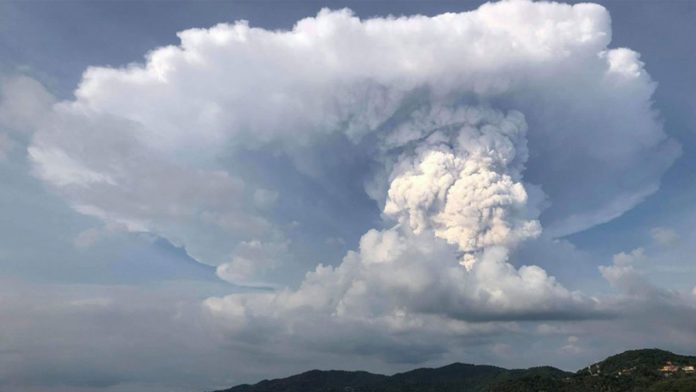The Philippine Institute of Volcanology and Seismology (PHIVOLCS) has recently raised an Alert Level 4 over the Taal Volcano after its phreatic or steam-driven eruption last Sunday, January 12. Alert Level 4 means an “imminent, hazardous” eruption could occur within hours or days.
Around 7,000 individuals have been evacuated from the affected areas, which include municipalities in Batangas and even Tagaytay. At the same time, several areas are also affected by the ash fall, including Cavite, Batangas, Rizal, the northwestern part of Quezon, Metro Manila, Bulacan, Pampanga, Bataan, Tarlac, Nueva Ecija, the eastern part of Pangasinan, and the southeastern part of Zambales.
It’s quite common for moms (and everyone else, for that matter) to be anxious in times of natural calamity such as these. But if you have small kids or babies, it’s best to keep a clear head and know what needs to be done to keep us and our families safe from harm.
What to do during a volcanic eruption
Since no one can predict or plot the timeline of volcanic eruptions, it’s best to know the steps needed to keep our families safe. The Department of Health (DoH) has issued guidelines on what to do during a volcanic eruption:
If you live near the active volcano:
- Listen to regular updates from the volcanic monitoring center — which in this case is PHIVOLCS or the local government units. Make sure that your phones have battery or you have radios on hand.
- Follow the advice of your local authorities. They will be the ones who will disseminate important and relevant information. They will also be the ones who will decide and signal evacuations in your area.
- Prepare survival kits and go bags for the entire family. This can include drinking water, food, clothes, first aid supplies, and medicines. Also, include battery-operated radios and flashlights.
- If you’ve been asked to evacuate, do so immediately. Bring your survival kits and go bags with you.
MAHALAGANG PAALALA: Kung ikaw ay nakatira malapit sa bulkang Taal, alamin kung paano maghahanda sa napipintong pagsabog…
Posted by Department of Health (Philippines) on Sunday, 12 January 2020
If you are outdoors:
- Seek shelter indoors immediately.
- If there’s falling debris, lie down and curl up like a ball to protect your head.
- If you’re located near bodies of water such as streams or rivers, monitor the water level and be mindful of lahar or mudflow. Evacuate immediately if needed.
- Look for and apply first aid remedies in cases of wounds or burns.
- If you feel that your throat, eyes, or nose are irritated due to the ash fall, immediately leave the area. If discomfort persists, please consult a medical practitioner.
- Use goggles or glasses to protect your eyes.
- Wear long-sleeved shirts and long pants to protect your skin as much as possible.
If indoors:
- Stay indoors, as much as possible.
- Close all doors and windows. Use wet curtains, cloths, or rags to seal any openings to prevent ash from coming in.
- Keep your pets indoors to also keep them safe from volcanic ash as it can be deadly to animals.
MAHALAGANG PAALALA: Alamin kung paano magiging ligtas sa pagputok ng bulkang Taal, ikaw man ay nasa loob o labas ng…
Posted by Department of Health (Philippines) on Sunday, 12 January 2020
If you need to go outside, it’s best to wear a dust mask to protect against respiratory irritation. N95 masks are recommended but if you don’t have one on hand, you can temporarily use a wet rag, cloth, or handkerchief. You should also refrain from using contact lenses and again, wear eye protection and keep as much of your skin covered.
You should also avoid driving in heavy ashfall as doing so can stir up ash that can clog engines and stall vehicles. If you need to drive, keep the car windows up (closed) and do not use the air conditioning system as doing so can bring in outside air and ash.
Additional reminders for families with babies and kids:
- Keep your kids and babies indoors, as much as possible. Try to minimize ash inside your home by keeping your windows and doors closed and using wet cloths to seal any openings.
- If you need to take them outside, use masks that are designed for children as it should fit well to work properly. Also, ensure that the kids would not have a hard time breathing when using the mask. If no approved masks are available for kids, you can also use wet rags or wet handkerchiefs.
- Prevent kids from playing in areas with ashfall. If ash is present at home, clean frequently to prevent continued exposure.
Inhalation and exposure to volcanic ash may cause lung irritation or exacerbation of respiratory illnesses such as asthma, cystic fibrosis, and tuberculosis.
Stay safe, mommies 🙏🏼
Join our MomCenter Community on our Facebook page and Facebook group for more insights on motherhood and parenting.





